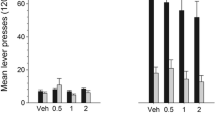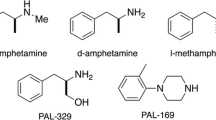Abstract
Rationale: The reinforcing effects of cocaine have been most compellingly related to its action as an indirect dopamine agonist. Although it is generally believed that both D1-like and D2-like receptor mechanisms may be involved, recent studies suggest that D1-like and D2-like agonists have differing profiles of cocaine-related actions. Objective: To develop a procedure for rapid assessment of complete dose–effect functions for cocaine self-administration in rhesus monkeys and to compare the effects of D1-like and D2-like agonists on cocaine self-administration using this procedure. Methods: Responding was maintained by various doses of cocaine or by food under a multiple-component schedule [fixed ratio (FR) 30; time out period (TO) 10 s] in 2-h sessions. After responding stabilized, the effects of pretreatment with D1-like and D2-like agonists (administered i.m., 10 min or 30 min prior to the session) were assessed. Results: Complete inverted U-shaped dose–effect functions for cocaine self-administration were obtained in all five rhesus monkeys trained with the rapid assessment procedure. Both the position and shape of the cocaine dose– effect function remained stable in repeated assessments, and levels of responding were controlled by the unit dose of cocaine rather than by other variables (e.g., infusion duration and volume) that were used to vary the cocaine dose. Pretreatment with the D1-like agonists SKF 82958 (0.32–1.8 mg/kg) and R-6-Br-APB (0.1–1.0 mg/kg) produced downward shifts in the cocaine dose–effect function at doses that also markedly decreased food-maintained responding. In contrast, pretreatment with the D2-like agonists quinelorane (0.001–0.01 mg/kg) and 7-OH-DPAT (0.01–0.10 mg/kg) shifted the cocaine dose–effect function to the left. D2-like agonists also increased responding maintained by the cocaine-associated cue lights alone, and moderately decreased food-maintained responding. Conclusions: The results suggest that D1-like and D2-like agonists produce qualitatively different effects on cocaine self-administration that may influence their usefulness for the treatment of cocaine abuse and dependence.
Similar content being viewed by others
Author information
Authors and Affiliations
Additional information
Received: 20 March 1999 / Final version: 10 August 1999
Rights and permissions
About this article
Cite this article
Caine, S., Negus, S. & Mello, N. Effects of dopamine D1-like and D2-like agonists on cocaine self-administration in rhesus monkeys: rapid assessment of cocaine dose-effect functions. Psychopharmacology 148, 41–51 (2000). https://doi.org/10.1007/s002130050023
Issue Date:
DOI: https://doi.org/10.1007/s002130050023




